COVID PROTOCOLS FOR PORTABLE PLANETARIUMS
Prof. Patricia Reiff, Rice University Physics & Astronomy Dept, Houston TX, MTPE Inc. DBA ePlanetarium
Sept, 2021
Abstract: The success of the COVID vaccines, and the return of school children to in-person classes, means that, if cautiously used, portable planetariums can return to being an important tool to Engage, Excite and Educate. This paper presents suggested updated protocols for the use of portable planetariums to ensure safety for the students and planetarium staff. |
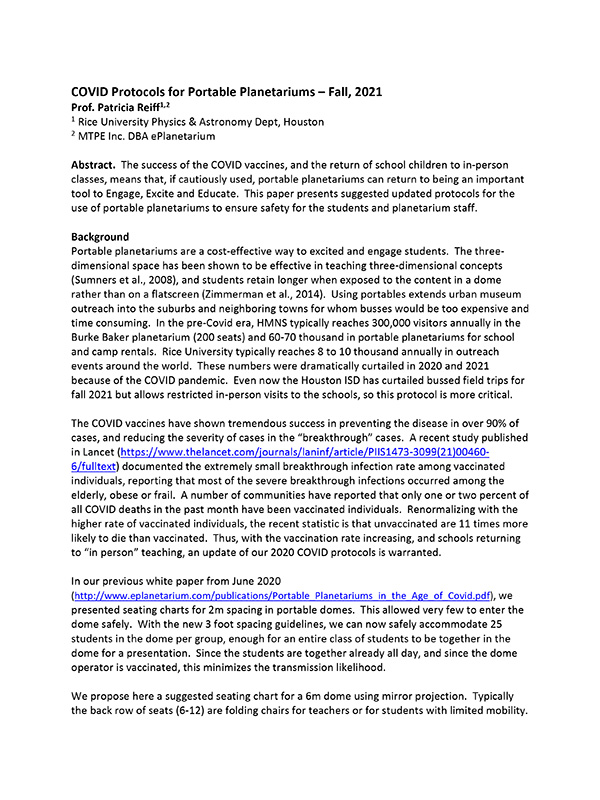 |
PORTABLE PLANETARIUMS IN THE AGE OF COVID-19
Prof. Patricia Reiff, Rice University Physics & Astronomy Dept, Houston TX, MTPE Inc. DBA ePlanetarium
June 19, 2020 (Updated 8/6/2020)
Abstract: "Social Distancing" seating in a portable dome is challenging, but it can be done.
If each person is a "single", the maximum seating is 9 for a mirror system or 8 for a fisheye system in a 6m dome. However, if family groups of 2 or more sit together, the maximum seating improves considerably. This white paper also makes suggestions on system cleaning and disinfection between groups and overnight. Air flow is also a consideration, with positive-pressure domes having generally more effective air flow and thus less time for contamination.
THIS DOCUMENT IS SUPERSEDED BY A NEWER SEPT 2021 VERSION |
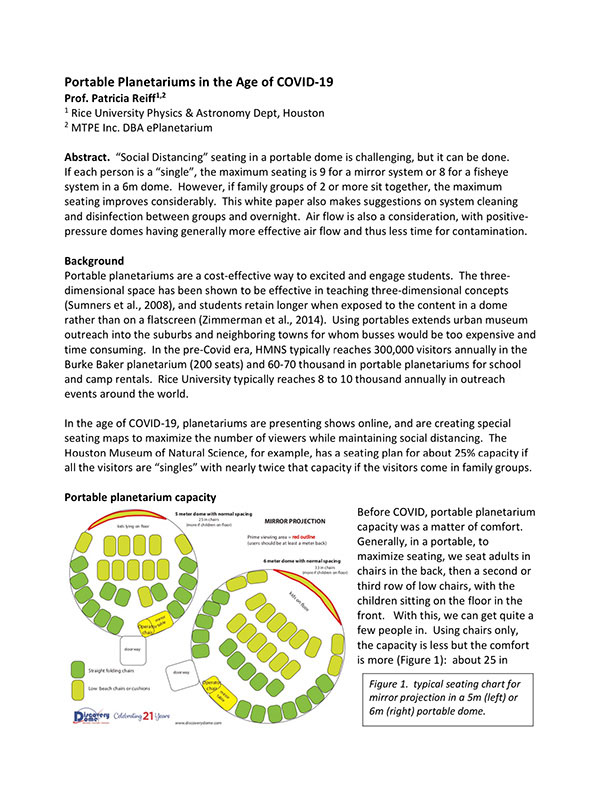 |
STREAMING SUBTITLED VIDEOS (INCLUDING FULLDOME PLANETARIUM SHOWS) VIA ZOOM
Patricia Reiff and Colin Law, Rice University Physics & Astronomy Dept, Houston, TX
Carolyn Sumners, Houston Museum of Natural Science
June 19, 2020
Abstract: We have been exploring ways to keep our planetarium shows in the public eye. With the closure of many planetariums due to the COVID-19 pandemic, we are streaming shows online instead. We have done tests of streaming planetarium shows via Zoom using various formats. We use "MediaShow" as our streaming software, since it allows multi-language subtitles on demand, and has excellent show control, invisible to the viewers. Developed under NASA cooperative agreement, it is available for a free 30-day trial from ePlanetarium.com. We have now shown a series of shows and have an established procedure for excellent quality at even modest download speeds, making an "immersive-like" feel to the viewers. |
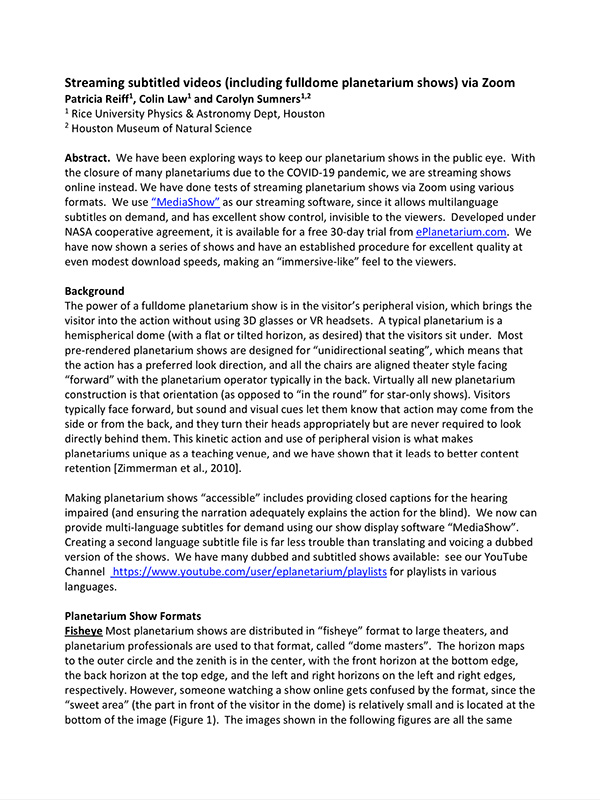 |
SPINOFF 2015 - NASA Spinoff Technology Across the Nation
2015
Each year, NASA’s Spinoff publication features the best recent examples of how NASA innovations now benefit our national and global communities. In this year’s book, you’ll find water bottles that use NASA-created filters to purify water from lakes and streams on the go; wind turbines, designed to withstand conditions on Mars, that are now powering communities across the world; and a heat shield developed by NASA that is helping the emerging commercial space industry soar to new heights. |
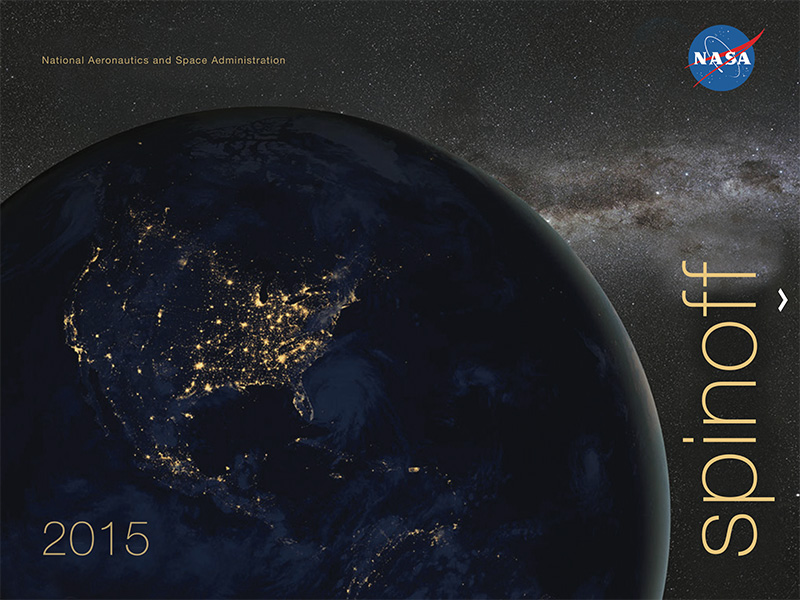 |
COMPARISON OF STUDENT LEARNING ABOUT SPACE IN IMMERSIVE AND COMPUTER ENVIRONMENTS
Laurie Zimmerman and Stacia Spillane, Houston Independent School District
Patricia Reiff, Rice University
Carolyn Sumners, Houston Museum of Natural Science
February 26, 2014; Accepted April 25, 2014
Abstract: This paper is the summary of the external evaluation of We Choose Space, a 24-minute planetarium show for audiences “who dream of space and wonder about human spaceflight after Shuttle,” in which we compared the student learning about space in digital and computer environments immediately afterwards and six weeks later. Paired t-tests and an independent t-test were used to compare the amount of learning that students achieved on the questionnaire. Interest questionnaires were administered to participants in formal (public school) settings and focus groups were conducted in informal (museum camp and educational festival) settings. Overall results from the informal and formal educational setting indicated that there was a statistically significant increase in test scores after viewing We Choose Space in both the portable Discovery Dome (9.75) as well as via the computer (8.88), when tested immediately after viewing. Most importantly, however, long-term retention of the material tested on the questionnaire was significantly better for the students who viewed it in the portable dome over those who learned by computer. Six weeks after viewing the content, the Dome students retained their gains in test scores (10.47), whereas computer-using students had lost most of their gain (3.49), and the improvements over the initial baseline for the computer learners were not statistically significant. |
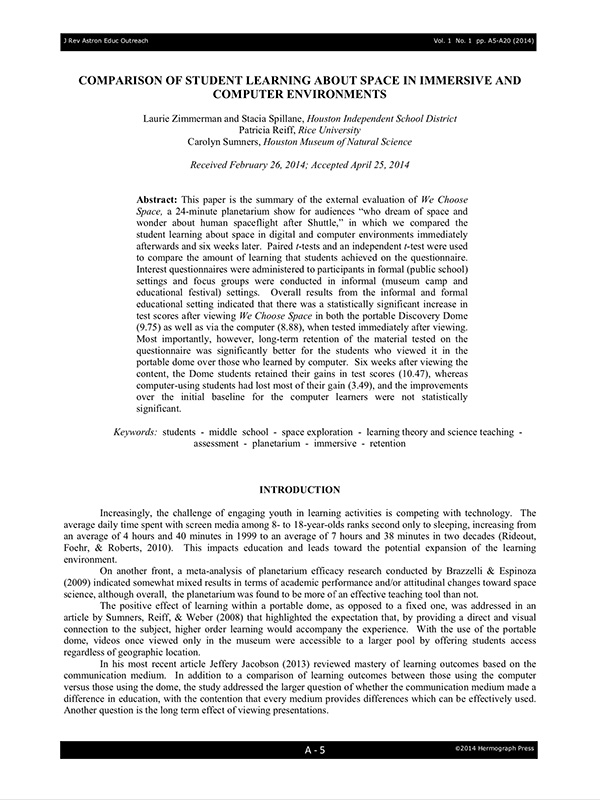 |
LEARNING IN AN IMMERSIVE DIGITAL THEATER
C. Sumners, Houston Museum of Natural Science
P. Reiff, Rice University
W. Weber, University of Houston
June 19, 2008
Abstract: The Houston Museum of Natural Science, in collaboration with Rice University has an outreach program taking portable digital theaters to schools and community sites for over five years and has conducted research on student learning in this immersive environment. By using an external independent evaluator, the effectiveness of NASA-funded Education and Public Outreach (EPO) projects can be assessed. This paper documents interactive techniques and learning strategies in full-dome digital theaters. The presentation is divided into Evaluation Strategies and Results and Interactivity Strategies and Results. All learners from grades 3–12 showed statistically significant short-term increase in knowledge of basic Earth science concepts after a single 22-min show. Improvements were more significant on items that were taught using more than one modality of instruction: hearing, seeing, discussion, and immersion. Thus immersive theater can be an effective as well as engaging teaching method for Earth and Space science concepts, particularly those that are intrinsically three-dimensional and thus most effectively taught in an immersive environment. The portable system allows taking the educational experience to rural and tribal sites where the underserved students could not afford the time or expense to travel to museums. |
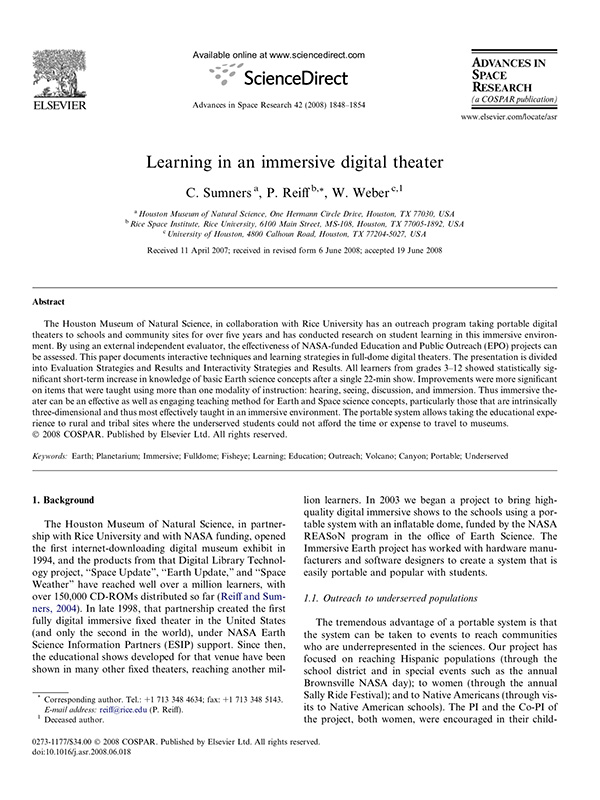 |
PLANETARIAN
Vol. 34, No. 2 - June 2005
Researchers from the Rice Space Institute, in partnership the Houston Museum of Natural Science, are leading a NASA-funded project to develop portable technology that will allow exciting new “fully immersive” planetarium programs to be shown across the country inside inflatable, classroom- sized domes. Immersive Earth is a five-year, $3.1 million project that brings together six museums, two universities, and three com- panies to create and distribute full-dome dig- ital planetarium shows nationwide. Immer- sive Earth aims for a wider audience through the development of a small, fully portable system that uses an inflatable dome and sin- gle-projector display. The Immersive Earth grant will also pay for the creation of three new programs: “Earth’s Wild Ride, which takes place in the year 2081, is now available; Earth in the Balance; and Earth in Peril.
Other participants in the program include both the Carnegie Museum of Natural His- tory and Carnegie Mellon University in Pitts- burgh, the Lodestar Planetarium in Albu- querque, the Oregon Museum of Science and Industry in Portland, the Louisiana Arts and Science Center in Baton Rouge, and the Smithsonian Museum of Natural History in Washington, D.C., Sky-Skan Inc., Homerun Pictures Inc. and iMove Inc. Recently, Space Update Inc. and Elumenati joined the list of participants to the project. For more infor- mation or to schedule a performance of this technology visit http://www.e-planetarium .com. See the front cover for a graphic from the program.
| 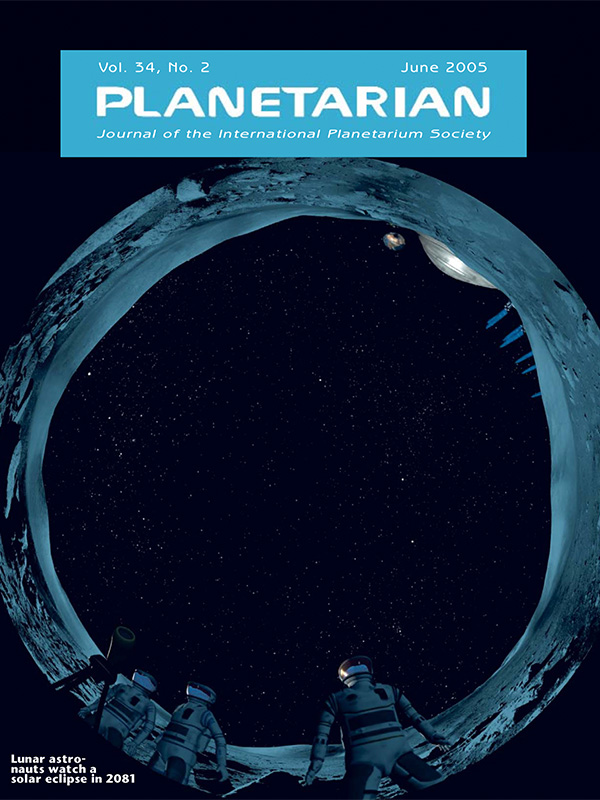 |






